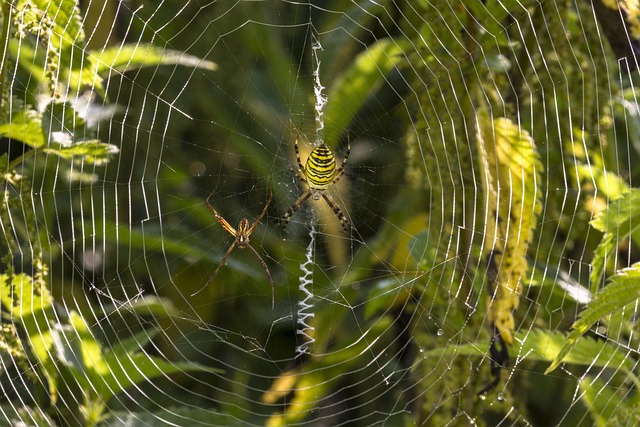Spiders prefer humid, secluded areas like basements, attics, and crawl spaces, making them prone to infestation. Professional spider control experts recommend identifying and sealing entry points, conducting regular inspections, and employing tailored strategies for each area (basements, attics, crawl spaces) to prevent and address infestations. Homeowners should also clean regularly, declutter, and consider professional services for safe, effective treatments. Prompt action is key upon spotting signs like webs, eggs sacs, silk threads, musty odors, or cracks around windows and doors.
Looking to reclaim your home from spiders? This guide unveils specialized prevention strategies tailored for basements, attics, and crawl spaces—often overlooked yet prime spider habitats. From understanding these arachnid hotspots to implementing effective DIY measures and recognizing signs of an infestation, you’ll discover the keys to effective, long-lasting protection. For severe cases, learn when and how to enlist professional spider control services.
Understanding Spider Habitats: Basements, Attics, and Crawl Spaces
Spiders are intricate creatures that prefer specific habitats, and understanding their preferences is key to effective spider control. Basements, attics, and crawl spaces offer ideal conditions for spiders to establish and breed due to their secluded nature, constant humidity, and easy access to food sources. These areas often go unnoticed, providing the perfect hiding spots for spider populations to thrive.
Professional spider control experts emphasize that identifying and sealing entry points is crucial. Cracks in walls, gaps around pipes, and poorly sealed doors or windows can serve as highways for spiders to infiltrate homes. Regular inspections by professionals ensure these tiny invaders are detected early, allowing for swift and targeted treatment to maintain a spider-free environment.
Professional Spider Control: Specialized Techniques for Each Area
When it comes to specialized prevention strategies, professional spider control is a crucial aspect of maintaining a pest-free home, especially in areas like basements, attics, and crawl spaces. These hard-to-reach nooks and crannies can easily attract spiders due to their secluded nature and proximity to potential food sources. However, implementing tailored techniques for each area is essential.
For basements, professionals may employ a combination of exclusion methods, sealing entry points, and setting up monitoring systems. In attics, the focus shifts to regular inspections, as spiders often spin webs here, and a proactive approach can prevent significant infestations. Crawl spaces require a unique strategy, including moisture control and the use of specialized equipment for deep treatment, ensuring no spider webs or eggs go unnoticed. Professional spider control services utilize these area-specific techniques to offer effective and long-lasting solutions, addressing the unique challenges posed by each space.
Preventative Measures: A Step-by-Step Guide for Homeowners
Preventative Measures: A Step-by-Step Guide for Homeowners
The first line of defense against spiders and other pests is a comprehensive, proactive approach. Homeowners can significantly reduce the risk of invasion by following some simple yet effective steps. Start with a thorough inspection—visually examining basements, attics, and crawl spaces to identify potential entry points, such as cracks or gaps in walls, foundations, or doors. Sealing these openings with caulk or weatherstripping is crucial, creating a physical barrier that discourages spiders from entering your home. Regular cleaning and decluttering are also essential; remove clutter and vacuum regularly to eliminate hidden spaces where spiders might hide.
Next, consider professional spider control services for targeted treatments. Experts can identify specific species and employ industry-leading methods to ensure a safe and effective elimination of arachnids. They may use a combination of techniques, including residual insecticides, natural repellents, or specialized equipment, tailored to the unique needs of each area. Following these preventative measures will not only keep your home free from spiders but also contribute to a healthier living environment for you and your family.
When to Call the Experts: Recognizing Signs of Infestation
Spider infestations in basements, attics, and crawl spaces can be a serious issue, indicating a larger problem with humidity or structural issues. Recognizing the signs early is crucial to prevent further infestation. Look for webs that appear out of place, especially in dark corners or hard-to-reach areas. Spiders often leave behind silk threads, so unusual accumulations could indicate their presence. If you spot eggs sacs or see live spiders, it’s time to call in a professional spider control service.
Additionally, keep an eye on any musty odors, as spiders are attracted to moist environments. Cracks and crevices, especially around windows and doors, can serve as entry points. When you notice these signs, don’t delay; professional spider control is essential to ensure a thorough and safe removal of the infestation, preventing them from returning.
In light of the above, it’s clear that specialized prevention strategies are key to keeping spiders at bay. By understanding their preferred habitats and implementing tailored measures in basements, attics, and crawl spaces, homeowners can significantly reduce spider infestations. For severe cases or when professional expertise is required, reliable spider control services offer advanced techniques tailored to each area. Following a step-by-step guide for preventative measures empowers folks to take control, ensuring their homes remain free from these eight-legged visitors. Remember that recognizing signs of infestation early on is crucial, so stay vigilant and don’t hesitate to call the experts when needed.
